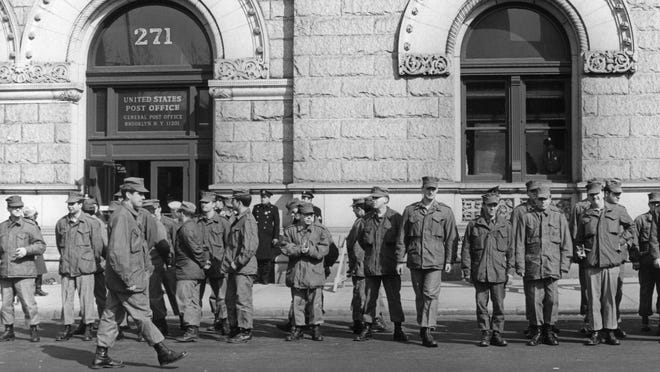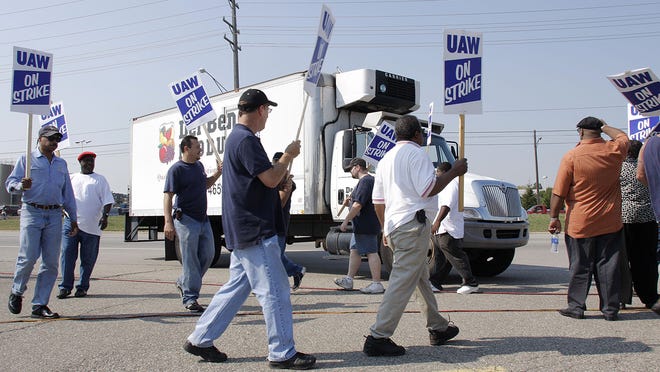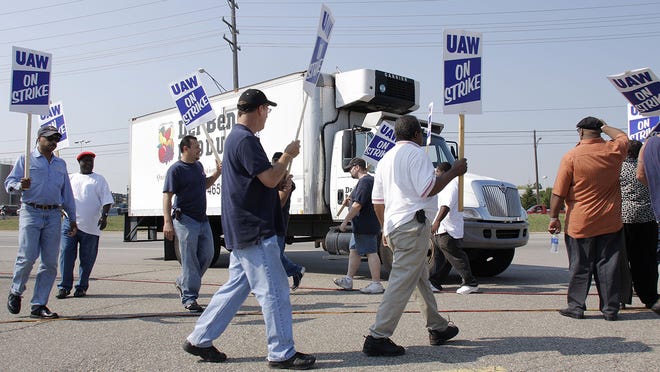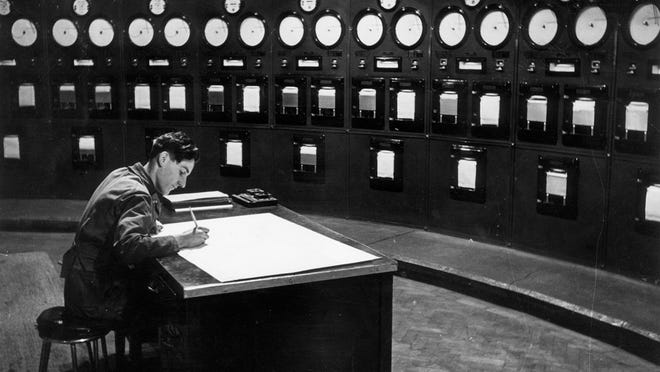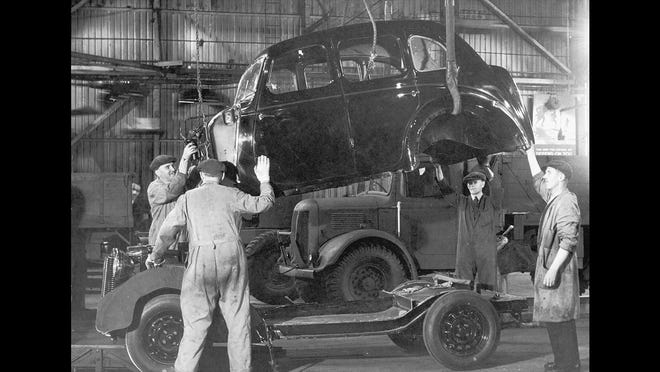It’s time for something better.
By Anna North Jul 13, 2021
/cdn.vox-cdn.com/uploads/chorus_image/image/69577287/GettyImages_1226216285.0.jpg)
Long and unpredictable work hours leave many Americans with little time for anything but their jobs. d3sign/Getty Images
The five-day workweek is so entrenched in American life that everything, from vacation packages to wedding prices to novelty signs, is built around it. When you live it every Monday through Friday, year in and year out, it can be hard to imagine any other way.
But there’s nothing inevitable about working eight hours a day, five days a week (or more). This schedule only became a part of American labor law in the 1930s, after decades of striking by labor activists who were tired of working the 14-hour days demanded by some employers. Indeed, one of the biggest goals of the American labor movement beginning in the 19th century was “an attempt to gain time back,” Erik Loomis, a history professor at the University of Rhode Island, told Vox.
And now, more than 15 months into the pandemic, there’s a growing conversation about how American workers can take back more of their time. The trauma and disruption of the last year and a half have a lot of Americans reevaluating their relationships to work, whether it’s restaurant servers tired of risking their safety for poverty-level wages or office workers quitting rather than giving up remote work. And part of that reevaluation is about the workweek, which many say is due for a reboot.
Over the past few decades, work for many salaried employees has ballooned far beyond 40 hours a week, thanks to a combination of weakened labor laws and technology that allows bosses to reach workers at any time of the day or night. At the same time, low-wage and hourly workers are frequently subject to unpredictable schedules that can change at a moment’s notice, and may not give them enough hours of paid work to live on. Today’s work schedules, with their combination of “overwork and then no work,” in many ways mirror the conditions that preceded the reforms of the 1930s, Loomis said.
Then as now, the country may be ripe for a change. Some employers are testing out four-day workweeks. A recent study of shorter workweeks in Iceland was a big success, boosting worker well-being and even productivity. And workers themselves are pushing back against schedules that crowd out everything that isn’t work. During the pandemic, there’s a growing feeling that “we have one life — and are we working to live, or are we living to work?” Rachel Deutsch, director of worker justice campaigns at the Center for Popular Democracy, told Vox.
But to really make the workweek fair and humane for all Americans — and give us more time to do things that aren’t work — the country will need systemic changes to help workers take back their power. Otherwise, only the most privileged will benefit from the new interest in shorter workweeks — if anyone benefits at all.
The 40-hour workweek was a hard-won victory for labor activists
In the 19th century, many factory and other low-wage workers were at work nearly all the time. The workweek was whatever your employer said it was, which “could be 14 hours a day, it could be six days a week, it could be seven days a week,” Loomis said. In “strike after strike after strike,” he explained, workers fought for a more livable schedule, a push exemplified by the 1880s slogan, “eight hours for work, eight hours for rest, eight hours for what we will.”
They won some victories — the Ford Motor Company, for example, reduced its workweek from 48 to 40 hours in 1926 (though that may have been more about Henry Ford’s conviction that fewer hours made workers more productive). But it wasn’t until the 1930s that the Great Depression and more mass strikes convinced President Franklin Delano Roosevelt and reformers in the federal government that something had to change.
The result was the Fair Labor Standards Act, passed in 1938, which — among other reforms — required overtime pay for many employees if they worked more than 40 hours a week. There were exceptions — farm workers, for example, were not guaranteed overtime — but for millions of workers, the eight-hour day and five-day week became the law of the land.
Not everyone wanted to stop there. “There really were battles in the ’40s and ’50s over whether or not the eight-hour day was sufficient,” Loomis said. Pushes for a six-hour day or other ways of shortening the workweek continued in the 1960s, but rising unemployment in the 1970s had labor leaders focusing all their attention on trying to save jobs. The idea of a shorter workweek fell by the wayside.
But since then, a lot of Americans’ work schedules have only gotten worse. For example, many salaried workers (as opposed to those paid an hourly wage) are exempt from the overtime requirements of the Fair Labor Standards Act, and employers have taken advantage of this to require more and more hours of these workers. As of 2014, the average salaried worker worked 49 hours per week, according to a Gallup survey, with 25 percent working more than 60 hours — and working hours for many have actually gone up, not down, during the pandemic.
Meanwhile, the rise of smartphones and laptops has broken down the barriers between work and home, allowing bosses to contact employees at any time of the day or night. As management professor Scott Dust wrote at Fast Company earlier this year, “thanks to technology, the eight-hour, ‘9-to-5’ workday is a mirage.”
Hourly workers, especially in low-wage service jobs, meanwhile, have faced a different problem: the rise of just-in-time scheduling, in which employers decide on worker schedules just days in advance, depending on factors like how busy a particular store is. That practice has led many large employers to keep most of their employees part-time, so they can be called in at a moment’s notice, and not paid when they aren’t needed. It’s a way of essentially “offloading all of the risk of your business model onto workers,” Deutsch said.
For workers subject to just-in-time scheduling, long workweeks aren’t necessarily the problem: rather, one-third of retail and food-service workers in one 2019 survey said they were involuntarily working part-time, wanting more hours than their employer would give them. That can make it difficult or impossible for people to pay their bills, necessitating a second job — except that unpredictable schedules make juggling two or more jobs complex, to say the least. And a constantly changing work schedule can also make it hard to arrange for child care — the same survey found that unpredictable schedules for parents led to instability in children’s routines, as well as anxiety and behavior problems in kids.
A constantly changing schedule meant that Madison Nardy, a former beauty consultant at a Philadelphia-area Target, never knew how much money she’d be taking home each week, as she struggled to balance work with attending community college and caring for her mom, who has a disability. Though she was hired with the understanding that she would work 30 or 35 hours a week, soon “my hours began to dwindle down,” she told Vox. “One week I would have eight hours, the next week it would go up to 20, and then back down to 12.”
The hours she did work could be punishing — sometimes she was scheduled to close the store at 1 am and come back the next morning at 7 or 8, a practice called “clopening.” Her constantly fluctuating schedule left her so exhausted and stressed that there were days “where I would go in the bathroom and just cry,” Nardy said. “I was always running around like a chicken without a head.”
The five-day workweek is so entrenched in American life that everything, from vacation packages to wedding prices to novelty signs, is built around it. When you live it every Monday through Friday, year in and year out, it can be hard to imagine any other way.
But there’s nothing inevitable about working eight hours a day, five days a week (or more). This schedule only became a part of American labor law in the 1930s, after decades of striking by labor activists who were tired of working the 14-hour days demanded by some employers. Indeed, one of the biggest goals of the American labor movement beginning in the 19th century was “an attempt to gain time back,” Erik Loomis, a history professor at the University of Rhode Island, told Vox.
And now, more than 15 months into the pandemic, there’s a growing conversation about how American workers can take back more of their time. The trauma and disruption of the last year and a half have a lot of Americans reevaluating their relationships to work, whether it’s restaurant servers tired of risking their safety for poverty-level wages or office workers quitting rather than giving up remote work. And part of that reevaluation is about the workweek, which many say is due for a reboot.
Over the past few decades, work for many salaried employees has ballooned far beyond 40 hours a week, thanks to a combination of weakened labor laws and technology that allows bosses to reach workers at any time of the day or night. At the same time, low-wage and hourly workers are frequently subject to unpredictable schedules that can change at a moment’s notice, and may not give them enough hours of paid work to live on. Today’s work schedules, with their combination of “overwork and then no work,” in many ways mirror the conditions that preceded the reforms of the 1930s, Loomis said.
Then as now, the country may be ripe for a change. Some employers are testing out four-day workweeks. A recent study of shorter workweeks in Iceland was a big success, boosting worker well-being and even productivity. And workers themselves are pushing back against schedules that crowd out everything that isn’t work. During the pandemic, there’s a growing feeling that “we have one life — and are we working to live, or are we living to work?” Rachel Deutsch, director of worker justice campaigns at the Center for Popular Democracy, told Vox.
But to really make the workweek fair and humane for all Americans — and give us more time to do things that aren’t work — the country will need systemic changes to help workers take back their power. Otherwise, only the most privileged will benefit from the new interest in shorter workweeks — if anyone benefits at all.
The 40-hour workweek was a hard-won victory for labor activists
In the 19th century, many factory and other low-wage workers were at work nearly all the time. The workweek was whatever your employer said it was, which “could be 14 hours a day, it could be six days a week, it could be seven days a week,” Loomis said. In “strike after strike after strike,” he explained, workers fought for a more livable schedule, a push exemplified by the 1880s slogan, “eight hours for work, eight hours for rest, eight hours for what we will.”
They won some victories — the Ford Motor Company, for example, reduced its workweek from 48 to 40 hours in 1926 (though that may have been more about Henry Ford’s conviction that fewer hours made workers more productive). But it wasn’t until the 1930s that the Great Depression and more mass strikes convinced President Franklin Delano Roosevelt and reformers in the federal government that something had to change.
The result was the Fair Labor Standards Act, passed in 1938, which — among other reforms — required overtime pay for many employees if they worked more than 40 hours a week. There were exceptions — farm workers, for example, were not guaranteed overtime — but for millions of workers, the eight-hour day and five-day week became the law of the land.
Not everyone wanted to stop there. “There really were battles in the ’40s and ’50s over whether or not the eight-hour day was sufficient,” Loomis said. Pushes for a six-hour day or other ways of shortening the workweek continued in the 1960s, but rising unemployment in the 1970s had labor leaders focusing all their attention on trying to save jobs. The idea of a shorter workweek fell by the wayside.
But since then, a lot of Americans’ work schedules have only gotten worse. For example, many salaried workers (as opposed to those paid an hourly wage) are exempt from the overtime requirements of the Fair Labor Standards Act, and employers have taken advantage of this to require more and more hours of these workers. As of 2014, the average salaried worker worked 49 hours per week, according to a Gallup survey, with 25 percent working more than 60 hours — and working hours for many have actually gone up, not down, during the pandemic.
Meanwhile, the rise of smartphones and laptops has broken down the barriers between work and home, allowing bosses to contact employees at any time of the day or night. As management professor Scott Dust wrote at Fast Company earlier this year, “thanks to technology, the eight-hour, ‘9-to-5’ workday is a mirage.”
Hourly workers, especially in low-wage service jobs, meanwhile, have faced a different problem: the rise of just-in-time scheduling, in which employers decide on worker schedules just days in advance, depending on factors like how busy a particular store is. That practice has led many large employers to keep most of their employees part-time, so they can be called in at a moment’s notice, and not paid when they aren’t needed. It’s a way of essentially “offloading all of the risk of your business model onto workers,” Deutsch said.
For workers subject to just-in-time scheduling, long workweeks aren’t necessarily the problem: rather, one-third of retail and food-service workers in one 2019 survey said they were involuntarily working part-time, wanting more hours than their employer would give them. That can make it difficult or impossible for people to pay their bills, necessitating a second job — except that unpredictable schedules make juggling two or more jobs complex, to say the least. And a constantly changing work schedule can also make it hard to arrange for child care — the same survey found that unpredictable schedules for parents led to instability in children’s routines, as well as anxiety and behavior problems in kids.
A constantly changing schedule meant that Madison Nardy, a former beauty consultant at a Philadelphia-area Target, never knew how much money she’d be taking home each week, as she struggled to balance work with attending community college and caring for her mom, who has a disability. Though she was hired with the understanding that she would work 30 or 35 hours a week, soon “my hours began to dwindle down,” she told Vox. “One week I would have eight hours, the next week it would go up to 20, and then back down to 12.”
The hours she did work could be punishing — sometimes she was scheduled to close the store at 1 am and come back the next morning at 7 or 8, a practice called “clopening.” Her constantly fluctuating schedule left her so exhausted and stressed that there were days “where I would go in the bathroom and just cry,” Nardy said. “I was always running around like a chicken without a head.”
The pandemic could be paving the way for a new workweek revolution
Nothing in the Fair Labor Standards Act prohibits the practices Nardy said she experienced — employers switching up workers’ schedules with little notice, or giving each employee too little work to live on. “The only protections that we have for hourly workers are from a time when overwork was the only problem,” Deutsch said.
Nothing in the Fair Labor Standards Act prohibits the practices Nardy said she experienced — employers switching up workers’ schedules with little notice, or giving each employee too little work to live on. “The only protections that we have for hourly workers are from a time when overwork was the only problem,” Deutsch said.
Recently, however, there’s been a growing push for workers’ rights in general, not just around scheduling. The Fight for $15, for example, has won minimum-wage increases in many states as well as drawing the attention of policymakers to issues facing hourly workers. “Labor reform is rising in the Democratic Party for the first time since the ’30s,” Loomis said, in part because “people are out in the streets demanding it.”
And the pandemic has only intensified that push. Record numbers of Americans across economic sectors are quitting their jobs, with nearly 4 million people handing in their notice in April alone. Whether it’s hourly retail workers frustrated with contingent schedules or more highly-paid salaried employees tired of working 60-hour weeks, there is “a broader consensus now that our work should sustain us,” Deutsch said. “Our whole life should not be at the mercy of a job that does not allow us to thrive.”
More livable schedules have had success elsewhere in the world. Companies in Japan, New Zealand, and elsewhere have experimented with shorter workweeks in recent years, often reporting happier workers who are actually better at their jobs. But one of the largest and most high-profile recent experiments took place in Iceland, where local and federal authorities working with trade unions launched two trials of a shortened workweek, one in 2015 and one in 2017. In the trials, workers shifted from a 40-hour work week to 35 or 36 hours, with no cut to their pay. It wasn’t just office workers who participated — the trials included day care workers, police officers, care workers for people with disabilities, and people in a variety of other occupations.
The results were impressive, according to a report on the trials published in June by Autonomy, a UK-based think tank that helped analyze them. Workers reported better work-life balance, lower stress, and greater well-being. “My older children know that we have shorter hours and they often say something like, ‘Is it Tuesday today, dad? Do you finish early today? Can I come home directly after school?’” one father said, according to the report. “And I might reply ‘Of course.’ We then go and do something — we have nice quality time.”
And perhaps counterintuitively, worker productivity generally stayed the same or actually increased during the trials. Workers and managers worked together to make changes like reorganizing shift changes and reducing meetings, Jack Kellam, an Autonomy researcher who co-wrote the report, told Vox. “These trials were not implemented top-down.”
Just having more rest may have helped people be more productive — as the Autonomy researchers note, overwork can lead to fatigue, which actually lowers productivity.
Encouraged by the results of the trial, many Icelandic workplaces have embraced shorter hours, with 86 percent of the working population either working shorter hours already or on contracts that will phase in the reduction in the coming years. The Autonomy report has also generated global interest at a time when workers and companies alike are rethinking what jobs should look like. For example, the shift to remote work over the last 15 months has shown that “quite drastic changes in working practices can happen quite quickly,” Kellam said. Now his work on the Iceland trials has gotten news coverage in countries from Australia to Germany, and several companies have approached Autonomy for advice on implementing shorter hours for their employees.
But making something like the Icelandic trials work in the United States would require major changes. For one thing, unions in Iceland, which represent 90 percent of workers, played a big role in negotiating both the trials and the long-term adoption of shorter hours that resulted. But union density is much lower in the United States, with just 10.8 percent of workers represented.
Making it easier to form unions would be a big step toward helping American workers negotiate better schedules, Loomis said. The PRO Act, which would reverse years of anti-union legislation at the state level, would be a start — but so far, it appears unlikely to pass the Senate.
As for unpredictable schedules, years of worker activism have led to fair workweek laws in cities like New York and San Francisco, which typically require employers to provide adequate notice of schedules (often two weeks ahead of time) and compensation for last-minute changes, as well as banning “clopening.” Rep. Rosa DeLauro (D-CT) and Sen. Elizabeth Warren (D-MA) have introduced such a law at the federal level, called the Schedules That Work Act — but it, too, has gained little traction with Republicans in the Senate.
Such nationwide changes can seem far-off, and in a country as work-focused as the United States, it can be hard to imagine reforms that would help (some) people work less. But some say the pandemic, along with growing worker activism in recent years, have created conditions similar to the 1930s, where big changes finally seem possible. The fact that labor law reform has close to universal support among Democrats in Congress — after decades of not being a priority for the party — is meaningful, Loomis said. And that happened in large part because workers demanded it.
Nardy is one of the workers agitating for change. She was part of a coalition that helped push Philadelphia to pass a fair workweek law in 2018, and now she’s studying political science at Temple University, with the goal of running for city council. “There isn’t really somebody sitting in office that really, genuinely cares about workers’ rights,” she said.
But one day, that person might be her. And although workers in the United States don’t yet have the kind of bargaining power they wield in other countries, their voices are growing louder, and their discontent more palpable, by the day. At this point in the pandemic, many are saying, “maybe the life I was leading that seemed inevitable, and never-changing, maybe I don’t want that,” Loomis said. It’s a kind of “spontaneous realization by millions of people that they could do better.”
And the pandemic has only intensified that push. Record numbers of Americans across economic sectors are quitting their jobs, with nearly 4 million people handing in their notice in April alone. Whether it’s hourly retail workers frustrated with contingent schedules or more highly-paid salaried employees tired of working 60-hour weeks, there is “a broader consensus now that our work should sustain us,” Deutsch said. “Our whole life should not be at the mercy of a job that does not allow us to thrive.”
More livable schedules have had success elsewhere in the world. Companies in Japan, New Zealand, and elsewhere have experimented with shorter workweeks in recent years, often reporting happier workers who are actually better at their jobs. But one of the largest and most high-profile recent experiments took place in Iceland, where local and federal authorities working with trade unions launched two trials of a shortened workweek, one in 2015 and one in 2017. In the trials, workers shifted from a 40-hour work week to 35 or 36 hours, with no cut to their pay. It wasn’t just office workers who participated — the trials included day care workers, police officers, care workers for people with disabilities, and people in a variety of other occupations.
The results were impressive, according to a report on the trials published in June by Autonomy, a UK-based think tank that helped analyze them. Workers reported better work-life balance, lower stress, and greater well-being. “My older children know that we have shorter hours and they often say something like, ‘Is it Tuesday today, dad? Do you finish early today? Can I come home directly after school?’” one father said, according to the report. “And I might reply ‘Of course.’ We then go and do something — we have nice quality time.”
And perhaps counterintuitively, worker productivity generally stayed the same or actually increased during the trials. Workers and managers worked together to make changes like reorganizing shift changes and reducing meetings, Jack Kellam, an Autonomy researcher who co-wrote the report, told Vox. “These trials were not implemented top-down.”
Just having more rest may have helped people be more productive — as the Autonomy researchers note, overwork can lead to fatigue, which actually lowers productivity.
Encouraged by the results of the trial, many Icelandic workplaces have embraced shorter hours, with 86 percent of the working population either working shorter hours already or on contracts that will phase in the reduction in the coming years. The Autonomy report has also generated global interest at a time when workers and companies alike are rethinking what jobs should look like. For example, the shift to remote work over the last 15 months has shown that “quite drastic changes in working practices can happen quite quickly,” Kellam said. Now his work on the Iceland trials has gotten news coverage in countries from Australia to Germany, and several companies have approached Autonomy for advice on implementing shorter hours for their employees.
But making something like the Icelandic trials work in the United States would require major changes. For one thing, unions in Iceland, which represent 90 percent of workers, played a big role in negotiating both the trials and the long-term adoption of shorter hours that resulted. But union density is much lower in the United States, with just 10.8 percent of workers represented.
Making it easier to form unions would be a big step toward helping American workers negotiate better schedules, Loomis said. The PRO Act, which would reverse years of anti-union legislation at the state level, would be a start — but so far, it appears unlikely to pass the Senate.
As for unpredictable schedules, years of worker activism have led to fair workweek laws in cities like New York and San Francisco, which typically require employers to provide adequate notice of schedules (often two weeks ahead of time) and compensation for last-minute changes, as well as banning “clopening.” Rep. Rosa DeLauro (D-CT) and Sen. Elizabeth Warren (D-MA) have introduced such a law at the federal level, called the Schedules That Work Act — but it, too, has gained little traction with Republicans in the Senate.
Such nationwide changes can seem far-off, and in a country as work-focused as the United States, it can be hard to imagine reforms that would help (some) people work less. But some say the pandemic, along with growing worker activism in recent years, have created conditions similar to the 1930s, where big changes finally seem possible. The fact that labor law reform has close to universal support among Democrats in Congress — after decades of not being a priority for the party — is meaningful, Loomis said. And that happened in large part because workers demanded it.
Nardy is one of the workers agitating for change. She was part of a coalition that helped push Philadelphia to pass a fair workweek law in 2018, and now she’s studying political science at Temple University, with the goal of running for city council. “There isn’t really somebody sitting in office that really, genuinely cares about workers’ rights,” she said.
But one day, that person might be her. And although workers in the United States don’t yet have the kind of bargaining power they wield in other countries, their voices are growing louder, and their discontent more palpable, by the day. At this point in the pandemic, many are saying, “maybe the life I was leading that seemed inevitable, and never-changing, maybe I don’t want that,” Loomis said. It’s a kind of “spontaneous realization by millions of people that they could do better.”










